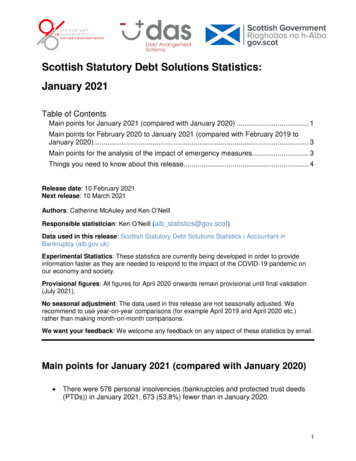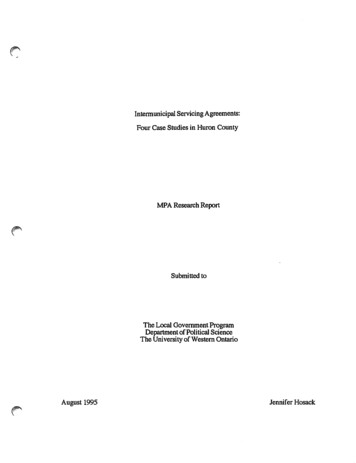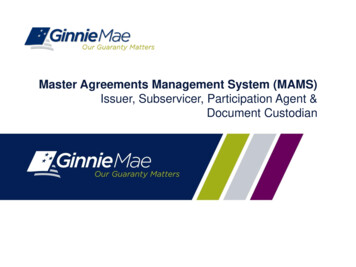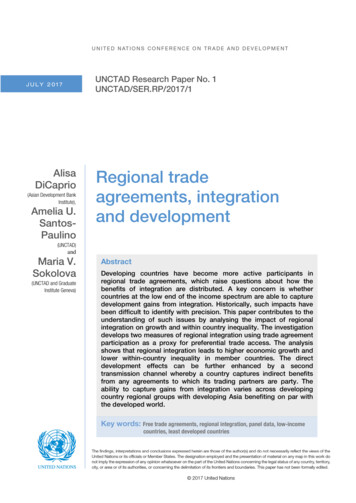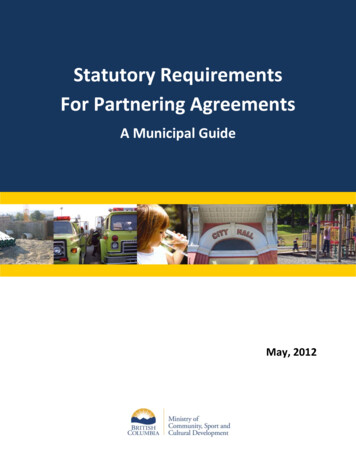
Transcription
Statutory RequirementsFor Partnering AgreementsA Municipal GuideMay, 2012
Table of ContentsIntroduction and Purpose . 1What is a Partnering Agreement? . 1When to Consider a Partnering Agreement . 2Service Life‐Cycle . 3Assistance to Business . 4Taxation of Partnership Property . 5Disposition of Property . 9Capital Financing: Under Agreement or by Loan Authorization Bylaw . 12Miscellaneous Requirements for Partnering Agreements . 14Summary of Relevant Sections of the Community Charter . 14Contact information. 15Appendix A – Contents of Notice . 16Ministry of Community, Sport andCultural DevelopmentiStatutory Requirements for PartneringAgreements: A Municipal Guide
Ministry of Community, Sport andCultural DevelopmentiiStatutory Requirements for PartneringAgreements: A Municipal Guide
Introduction and PurposeA partnering agreement is a contractual tool available to municipalities to provide a municipal servicethrough a third party (e.g. another local government, business, or not‐for profit organization).Many of the statutory provisions relating to partnering agreements can be found in separate sections of theCommunity Charter. The purpose of this guide is to assist municipal councils and staff to better understandpartnering agreements by consolidating and summarizing the principal statutory provisions governing theseagreements into a single guide. The guide is also intended to assist council and staff in understanding thevarious legal requirements for a partnering agreement and some of the options available.Note: This guide provides a high‐level overview of the statutory requirements concerningpartnering agreements for municipalities in British Columbia. For detailed information andbest practices, please consult “Private Public Partnership: A Guide for Local Government” at:http://www.cscd.gov.bc.ca/lgd/policy research/library/public private partnerships.pdf.What is a Partnering Agreement?A partnering agreement is defined under the Community Charter as an agreement between a municipalityand another party (e.g. public authority or person) whereby the other party agrees to provide a service onbehalf of the municipality. A municipality’s authority to enter into a partnering agreement is provided undersection 8(2) of the Community Charter, which states:“A municipality may provide any service that the council considers necessary or desirable,and may do this directly or through another public authority or another person ororganization.”Three important terms in the above statement are bolded and require further elaboration (Service, PublicAuthority, and Person).What is a Service?Section 8 of the Community Charter empowers municipalities with extensive authority to provide any servicethat council considers necessary or desirable. A “service” is broadly defined under the Community Charterto include any activity, work or facility undertaken or provided by or on behalf of a municipality. TheCommunity Charter does not designate specific types of services (e.g. garbage); instead, services arebroadly governed within the scope of a municipality’s purpose, as articulated under section 7 of theCommunity Charter. Municipal purposes include: providing good government to the community;providing for services, laws, and other matters for community benefit;providing for stewardship of public assets; and,fostering the economic, social and environmental well‐being of its community.Ministry of Community, Sport andCultural Development1Statutory Requirements for PartneringAgreements: A Municipal Guide
Some examples of services include: frontline service delivery (e.g. garbage and recycling pickup); building and facility management (e.g. operations and maintenance of a water treatment plantor recreation facility); design and engineering work (e.g. planning work for a sewage treatment system); and, information systems and computer support.What is a Public Authority?A “public authority” under the Community Charter is generally a government, or agent of a government,and includes the following: Canadian Government; British Columbia Government; other provincial governments; B.C. local governments; First Nations; improvement districts; the Islands Trust; school boards, public universities and colleges; library boards; public hospitals and regional health authorities; and, government bodies in other provinces or countries that provide local government services.What is a Person?A “person”, defined under section 29 of the Interpretation Act, includes both a “natural person” (e.g. ahuman being in full capacity of the law) as well as not‐for‐profit and business organizations (e.g. societies,corporations and partnerships). Where the partner in a “partnering agreement” is a private (for‐profit)company, the partnering agreement is often referred to as a public private partnership or “P3”.When to Consider a Partnering AgreementMunicipalities provide services to address pressing public needs, such as clean water, proper sanitation, andparks and recreation. The Community Charter provides municipalities with the broadest range of tools tofind the most efficient and effective way of delivering these services, including the authority to undertakepartnering agreements.Municipalities may choose to enter into a partnering agreement for a number of reasons, including: potentialcost‐savings (i.e. value for money); outside expertise; risk sharing; and, operational independence.Ministry of Community, Sport andCultural Development2Statutory Requirements for PartneringAgreements: A Municipal Guide
Reason 1 ‐ Value for Money – Partnering agreements provide municipalities with a broad range of servicedelivery options beyond regular delivery of services through a municipal department. Partnering agreementsalso enable municipalities to compare different options for service delivery (as well as different serviceproviders) to determine the most cost‐effective and efficient means of providing a given service. Forexample, a municipality may examine the cost feasibility of providing a service (or some component of aservice) either through a municipal department or a number of potential partners.Reason 2 ‐ Expertise – A partner often brings a highly specialized expertise that the municipality may lack.This expertise may be in a specific area of operations (e.g. computer systems) or a particular service (e.g.water treatment).Reason 3 ‐ Risk‐Sharing – Many services (such as water and sewer) involve considerable investment in capitalinfrastructure. With considerable investment comes considerable risk (such as cost overruns, delays,environmental and regulatory compliance, and long‐term financing). A municipality may mitigate some or allof these risks by sharing them with an external partner under a partnering agreement. For example, apartnering agreement may stipulate that any capital cost overruns would be borne by the partner, ratherthan the municipality.Reason 4 ‐ Arms Length Independence – Because of the complex and highly technical nature of someservices, a municipal council may consider a partnering agreement as a means of removing the service fromthe political involvement in day‐to‐day operations. In this case, the terms of the partnering agreement mayprovide long‐term strategic plans and objectives for service delivery. The municipal council would removeitself from the operational decisions of a service, provided the partner meets the contractually agreed‐uponplans and objectives for that service.Note: While partnering agreements provide municipalities with broader options for servicedelivery, it is incumbent on municipal council and staff to conduct a business case analysis, orother due diligence, to determine if a partnering agreement is the most cost‐effective andefficient option for delivering a given service.Service Life‐CycleServices, specifically capital‐intensive services, follow a life‐cycle path through their creation, developmentand ongoing operations. This life‐cycle is sometimes referred to as DBFO – named after each step in the life‐cycle (Design, Build, Finance and Operate).1. Design – involves the design and planning of a service including the design and planning of relatedfacilities – e.g. architectural, engineering and planning studies.2. Build – involves capital acquisition and construction – e.g. procurement, property acquisition,preparation and building construction.3. Finance and Own – involves financing and control of capital (e.g. land, buildings, infrastructure andequipment) plus the financing of ongoing operations – e.g. debenture debt, leaseback agreements,tax exemptions, and fees for service.4. Operate – involves the ongoing operations of a service – e.g. training, technical staffing,administration, maintenance, and service support.Ministry of Community, Sport andCultural Development3Statutory Requirements for PartneringAgreements: A Municipal Guide
The Community Charter provides municipalities an extensive range of legislative authority to utilizepartnering agreements for one or more of these steps in the service life‐cycle. Because of this, a partneringagreement may be very narrow in scope or it may be broad.The broadest use of the partnering agreement involves all steps in the service life‐cycle (e.g. where a partneris responsible for designing, building, financing, and operating a water service under contract with amunicipality). In some cases, the partner may own or maintain broad control of the facilities related to theservice. Given the diversity of partnering agreements and the potential for numerous operating and capitalissues, the Community Charter identifies four key areas for local government consideration, including:1.2.3.4.assistance to business;taxation of partnership property;disposition of municipal property; and,capital financing.The remainder of the guide will provide a detailed focus on the statutory requirements surroundingeach of these four issues.Assistance to BusinessUnder the Community Charter, “Assistance” is defined as a benefit or advantage provided by amunicipality to a third party. Types of assistance often include grants, tax/fee exemptions, lowinterest loans, loan guarantees, and disposition of property below market value.Partnering agreements sometimes involve special assistance to the partner in return foroperating a municipal service. However, there is a general prohibition (under section 25 of theCommunity Charter) against a municipality providing assistance to a business. This is to ensure amunicipal government does not provide an advantage to one business at the expense of othercompeting businesses – thereby guaranteeing a level playing field for all businesses within themunicipality.A Business is an organization (or an area of operations) carrying on commercial orindustrial activity or providing personal or professional services for profit, but doesnot include corporations or agencies of the Provincial Government or South Coast BCTransportation Authority.For a partner that is also a business, the Community Charter recognizes that a partneringagreement is distinct from normal business operations of the partner because it involves theprovision of a service on behalf of a municipality. Therefore, the general prohibition of assistancedoes not apply to a business providing a municipal service under a partnering agreement(Community Charter, section 21).Ministry of Community, Sport andCultural Development4Statutory Requirements for PartneringAgreements: A Municipal Guide
Note: the prohibition on a municipal council providing assistance only applies to businesses;it does not apply to most government or not‐for‐profit organizations regardless of whetheror not they are in a partnering agreement.Notice of AssistanceIf a municipality intends to provide assistance through a partnering agreement, it must post a public notice inaccordance with sections 24 and 94 of the Community Charter in order to ensure transparency and publicaccountability. The public notice involves: posting of notice in a public posting place (normally identified in the municipality’s procedure bylawand may include a municipal hall or website);ANDo publication of notice in a local newspaper once each week for two consecutive weeks;OR,o if publication in a newspaper is not practical, providing notice by alternative means onceeach week for two consecutive weeks (except in the case of door‐to‐door distribution ofinformation, which need only be delivered once).The contents of a notice may vary depending on the specific content of a partnering agreement. Appendix A(p. 16) provides a general description of the contents for a public notice. In order to ensure transparency ofthe process, municipalities must provide the required public notification prior to providing any assistanceunder the agreement. Certain types of assistance (such as property tax exemptions) require municipalities tofollow additional statutory provisions outlined in the Community Charter.Taxation of Partnership PropertyOne of the most common forms of assistance under a partnering agreement is a total or partial taxexemption for property related to the provision of a municipal service under agreement. For example, abusiness that operates a privately‐owned water treatment facility under a municipal partnering agreementmay be eligible for a property tax exemption.Because taxation can be very complex, a municipality may benefit from consultation with the Ministry, BritishColumbia Assessment, or legal counsel before proceeding with a tax exemption in relation to an agreement.Types of PartnersWhen considering a tax exemption in relation to a property owned or occupied by a partner, a municipalitymust first determine the legal structure of the partner (i.e. is it another government, public authority, privatecompany, not‐for‐profit organization, or some other entity). This is an important distinction becausedifferent legal entities have different tax treatment under the Community Charter.Ministry of Community, Sport andCultural Development5Statutory Requirements for PartneringAgreements: A Municipal Guide
Important TermsProperty, Property Taxes, and Taxing AuthoritiesProperty – For the purpose of taxation, the term “property” includes land andimprovements; improvements are buildings, fixtures, and structures affixed to the land.Property Tax – A tax levied on the net taxable value of the property (also called an advalorem tax), or a tax levied per parcel, or on the frontage or area of a parcel.Taxing Authorities – public authorities (e.g. hospital districts, regional districts, the Provinceon behalf of school districts), that either set their own tax rates or requisition tax amountsfrom municipalities. Municipalities are legally obligated to collect these taxes within theirboundaries and remit the collected taxes to the appropriate taxing authority.Tax ExemptionsProperty Tax Exemption – an exemption from property tax; may be based on the type of theowner (e.g. the Provincial Government) and/or the use of the property (e.g. for charitablepurposes).Types of Tax Exemptions:Automatic Exemption – a tax exemption provided for by statute which, if the criteria forexemption are met, applies automatically (i.e. does not require council approval).General Permissive Exemption – a tax exemption provided at the discretion of a municipalcouncil in accordance with section 224 of the Community Charter.Partnering Exemption – a specific type of permissive tax exemption provided under section225 of the Community Charter. This is provided at the discretion of a council and inaccordance with a partnering agreement.Ownership/OccupationOwnership – defined in the Community Charter; generally refers to fee‐simple ownershipbut may also include other types of ownership or deemed owners (e.g. an occupier of Crownor municipally‐owned property is deemed to be an “owner”).Occupation – as defined in the Community Charter; generally refers to property held underlease, license or other tenure. Note: occupation of property is not an issue unless the ownerof the property is exempt; in which case, the occupier may be deemed taxable under certaincircumstances.Entities that are Automatically ExemptSome entities are automatically exempt from property tax by statute or the Constitution Act, 1867.Municipal councils have no exemption discretion regarding such entities; they are automatically exempt byBritish Columbia Assessment. Therefore, if these entities are part of a partnering agreement, they do notrequire any permissive exemption by the municipal council because they are already exempt.Ministry of Community, Sport andCultural Development6Statutory Requirements for PartneringAgreements: A Municipal Guide
Also, an automatic exemption applies to all property taxes of the municipality and other taxing authorities(e.g. regional districts, hospital districts, Province on behalf of school districts).Examples of this type of entity are the Federal and Provincial Governments. Property that belongs to thesegovernments is exempt under section 125 of the federal Constitution Act, 1867 even if the properties areheld under lease by an exempt owner.Other examples of automatic exemptions include entities under section 220 of the Community Charter suchas: public libraries under the Library Act; cemeteries under the Cremation, Internment and Funeral ServicesAct; and, hospitals under the Hospital Act.Entities Eligible for a General Permissive ExemptionA municipal council has the power to adopt (by bylaw) general permissive exemptions under section 224 ofthe Community Charter for eligible properties. Examples of entities that may be exempted under this sectioninclude neighbouring local governments or charitable, philanthropic or other not‐for‐profit corporations thatown or hold property, where the municipal council is satisfied that the property is used for the purposes ofthe not‐for‐profit corporation.Depending on the type of exemption under section 224, the duration of the general permissive exemptionmay be limited to 10 years (with the possibility of renewal). The prohibition against assistance to businessunder section 25 of the Community Charter may also apply.As is the case with an automatic exemption, general permissive exemptions trigger exemptions from all otherproperty taxes levied for other taxing authorities such as regional districts, hospitals districts, and theProvince on behalf of school districts.Use of Property by an Otherwise Exempt PartnerFor both automatic and general permissive exemptions, a municipality must carefullydetermine whether the potential partner is exempt for all purposes (or only under certainconditions). For example, under section 129 of the School Act, a school board property isonly exempt if it is used for the purposes listed in that section, including purposes of (orancillary to) a school. Also, under section 15 of the Health Authority Act, property of ahealth authority is only exempt if it is used for the purposes of that Act.Thus, the use of a property under a partnering agreement will affect whether or not it iseligible for an automatic or general permissive tax exemption. If the municipal councilwants to exempt a partner and circumstances do not meet the parameters for an automaticor general permissive exemption, the municipality may still exempt the property under apartnering exemption in accordance with section 225 of the Community Charter. Apartnering exemption may also be used in lieu of a general permissive exemption if thepartner is eligible for both the general permissive and partnering exemptions.Ministry of Community, Sport andCultural Development7Statutory Requirements for PartneringAgreements: A Municipal Guide
Entities Eligible for a Partnering ExemptionSome entities are not eligible for either an automatic or general permissive exemption and are otherwisefully taxable; however, such an entity may be eligible for a partnering exemption. Under section 225 of theCommunity Charter, a municipal council may permissively grant a tax exemption on property owned oroccupied by the partner and used for the provision of a municipal service under a partnering agreement. Thisis done through an exemption bylaw and in accordance with the terms and conditions of an exemptionagreement. The exemption bylaw under this section requires the approval of at least two‐thirds of council.The exemption agreement under section 225(5) and (6) of the Community Charter allows council to setthe following: extent of the exemption;a covenant on the property under S. 219 of the Land Title Act;relevant conditions for the exemption; and,appropriate terms for breach of those conditions, including:o discharge of any relevant covenant under the Land Title Act; and,o payment of amounts from the partner to the municipality in accordance with theagreement.While a partnering exemption requires more process than a general permissive exemption, undersection 224 of the Community Charter, it: grants the municipality broader authority to set terms and conditions for exemption eligibility;provides possible financial consequences if terms and conditions of the exemption agreementare not met by the partner; and,allows the duration of the exemption to exceed 10 years. This is beneficial because mostgeneral permissive exemptions under section 224 of the Community Charter are limited to 10years unless renewed by a future council, whereas the duration of a partnering agreement mayexceed this 10‐year limit. Thus, the partner may want certainty that the tax exemption extendsbeyond 10 years.Note: Partnering exemptions are not subject to the prohibition against assistance tobusiness under section 25 of the Community Charter.Unlike automatic exemptions or general permissive exemptions, a partnering exemption does notautomatically trigger an exemption from property taxes for other taxing authorities (e.g. regional districts,hospital districts, and the Province on behalf of school districts). For a partnering exemption to apply tothese other types of property taxes, the Lieutenant Governor in Council (Cabinet) must pass a regulation inaccordance with section 131(6) of the School Act.Ministry of Community, Sport andCultural Development8Statutory Requirements for PartneringAgreements: A Municipal Guide
Examples of partners that may be exempt under a partnering agreement include for‐profit businesses andother organizations that are not eligible for automatic or general permissive exemptions. For example, amunicipal arena may be owned by a private, for‐profit partner and leased to a municipality. In suchcircumstances, the for‐profit partner would normally be taxable. However, if this lease arrangement waspart of a partnering agreement, the arena may be exempt from property taxation using a partneringexemption.Note: Both general permissive and partnering exemptions require a public notice inaccordance with sections 94 and 227 of the Community Charter (see Appendix A, p. 16).Also, in order to be effective in the current tax year, a general permissive exemption bylaw(under section 224 of the Community Charter) or a partnering exemption bylaw (undersection 225 of the Community Charter) must be passed on or before October 31 of theprevious year.Exemptions for Sub‐OccupiersTax exemptions under a partnering agreement only apply to property owned or occupied by the municipalityor the partner. In some cases, there may be secondary occupiers on the property who are neither themunicipality nor the partner. An example of this is a clubhouse for a local not‐for‐profit sport club located onthe premises of a recreation facility providing a municipal service under a partnering agreement. Normally,such property would be taxable in the name of the non‐profit sports club because it would be considered ataxable occupier under the Community Charter.However, a municipal council may grant such a permissive tax exemption for property occupied by a sub‐occupier in accordance with section 224(2)(e) of the Community Charter. In order for council to grant suchan exemption, the following criteria must be met: sub‐occupied portion of the property is located within the broader property providing a municipalservice under a partnering agreement;broader property has been provided a partnering exemption under section 225 of theCommunity Charter;partnering agreement expressly contemplates that council may provide exemptions to sub‐occupiersunder the authority of section 224(2)(e) of the Community Charter; and,sub‐occupied property would otherwise be eligible for an automatic or general permissive taxexemption if it were owned by the sub‐occupier.Note: An exemption for a sub‐occupier cannot override the prohibition on assistance tobusiness. Thus, this exemption authority cannot be used to exempt a business sub‐occupying property that is subject to a separate partnering agreement. For example, if a for‐profit restaurant franchise sub‐occupies a portion of a recreation facility, and the facility issubject to partnering exemption, the restaurant is still taxable.Ministry of Community, Sport andCultural Development9Statutory Requirements for PartneringAgreements: A Municipal Guide
Disposition of PropertyPartnering agreements may involve the disposition of municipally‐owned property (i.e. land orimprovements) to the partner as a condition of the service agreement. Under section 8(1) of the CommunityCharter, municipalities have the capacity, rights, powers, and privileges of a natural person (referred to asnatural persons powers), including the power to acquire and dispose of property.Disposition, under the Interpretation Act, is a means to transfer by any method (including:to assign, give, sell, grant, convey, lease, divest and others).Municipalities also have a responsibility to provide stewardship of public assets as outlined in section 7(d) ofthe Community Charter. In accordance with this stewardship requirement, the Community Charterplaces restrictions on disposition of critical municipal property.At a minimum, the disposition of municipal property requires a public notice in accordance with sections26 and 94 of the Community Charter. This allows for transparency and public input into the dispositiondecision (see Appendix A – public notice requirements). Such a disposition would normally be done inconjunction with an operating agreement (i.e. an agreement that the partner operate the property formunicipal benefit and in accordance with the terms of the partnering agreement).Example: a municipality may dispose of a facility through a nominal lease to a privatepartner; in turn, the private partner will operate that facility in accordance with the terms ofthe partnering agreement.In addition to the general notice requirements for property disposition in Appendix A, there are fourscenarios that have additional statutory requirements as set out under sections 24, 27 and 28 of theCommunity Charter. These additional requirements involve the disposition of specific types of property, suchas:1.2.3.4.properties involved in capital intensive service delivery (e.g. utilities);properties involved in public health (water and sewer services);public parks; and,properties disposed of below fair market value.Each of these four scenarios is examined in more detail in the next part of this guide.Ministry of Community, Sport andCultural Development10Statutory Requirements for PartneringAgreements: A Municipal Guide
Elector ApprovalSome components of partnering agreements discussed in this guide (e.g. property dispositionand liabilities) may require the approval of the citizens of the municipality (called the electors).This approval can take one of two forms under the Community Charter:Assent of the Electors – this approval process requires a majority vote of the eligible electors in amunicipality (similar to a public referendum process).Approval of the Electors – this form of approval includes either the assent of the electors(mentioned above) or an alternative approval process. The choice is at the discretion of council.Under an alternative approval process, council will publish a notice of approval (see Appendix A,p 16). Electors will have at least one month to petition against the substance of that notice (e.g.adoption of an agreement or bylaw).If, at the end of the one month period, less than 10% of the eligible electors of the municipalitypetition against the substance of the notice (as certified by the municipal corporate officer), thesubstance of the notice is deemed to have received the appro
service. Given the diversity of partnering agreements and the potential for numerous operating and capital issues, the Community Charter identifies four key areas for local government consideration, including: 1. assistance to business; 2. taxation of partnership property; 3.







